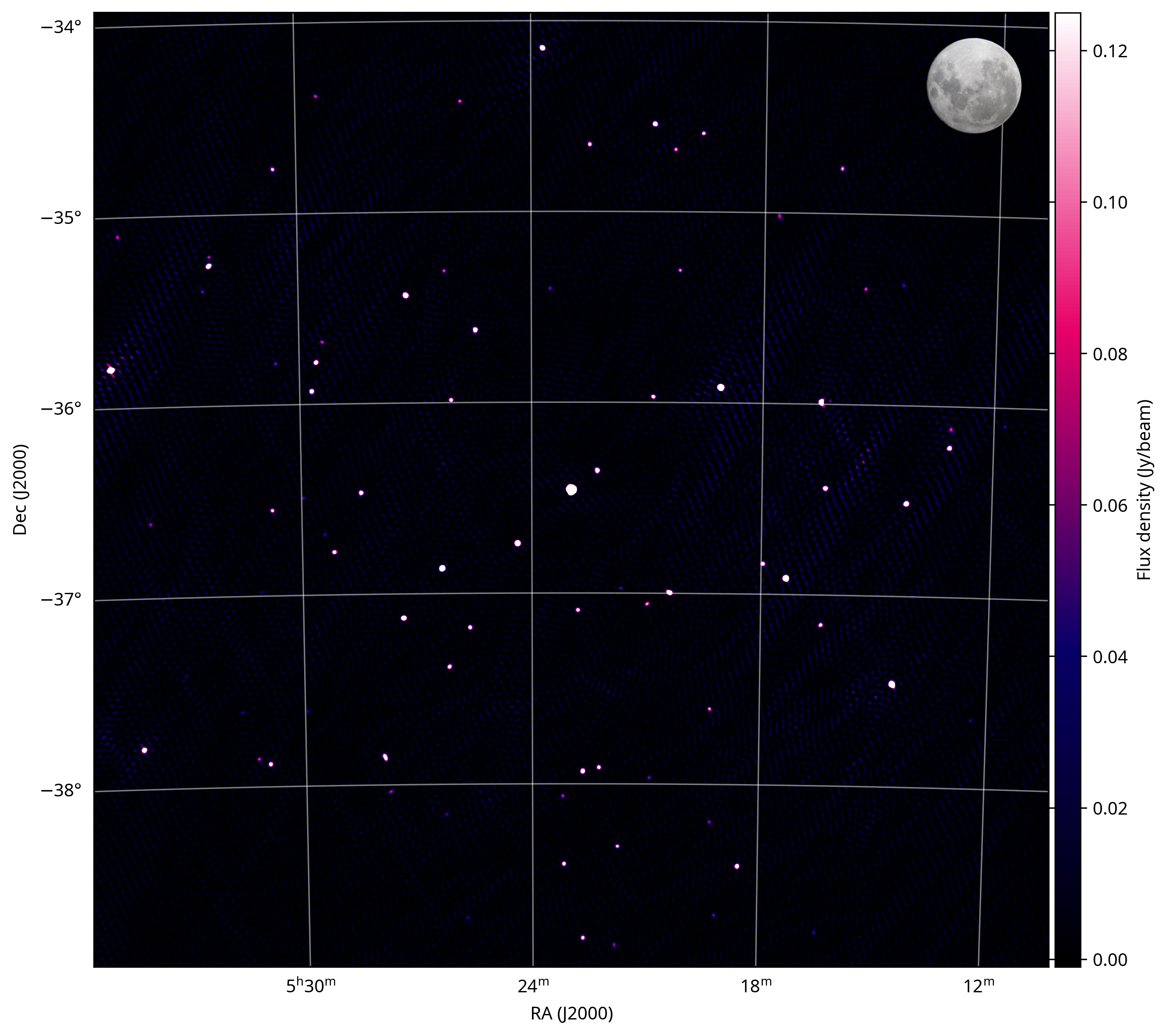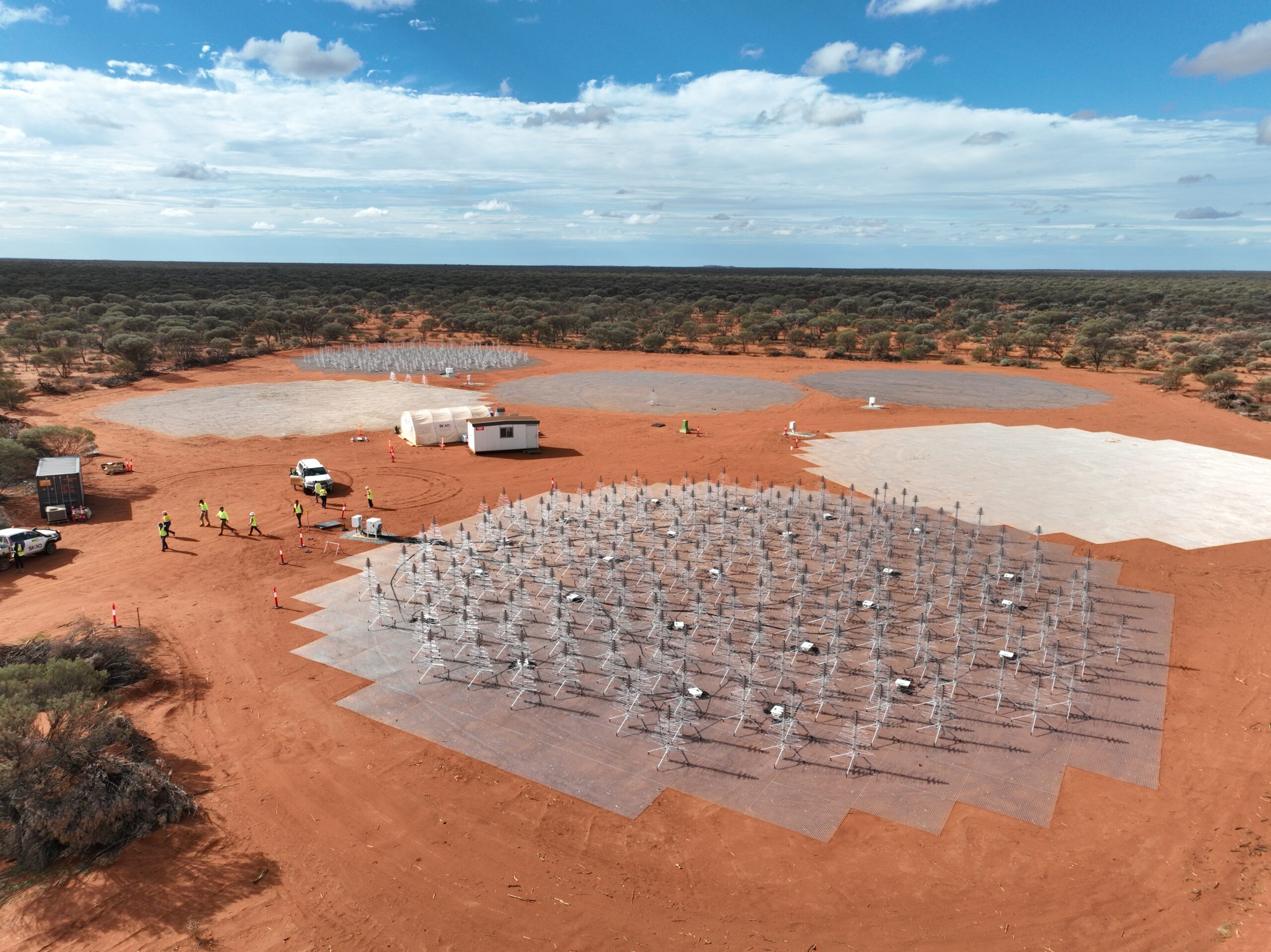SKA-Low captures its first image of the universe
March 17, 2025 – The first image from the SKA-Low radio telescope was released today. SKA-Low is part of the SKA Observatory (SKAO) and is located in Australia. This marks a significant milestone in SKAO's mission to provide an unprecedented view of our universe.

The first image using four stations of SKA-Low. The full moon in the upper right corner is shown for image size reference. Credit: SKAO
The image covers an area of the sky approximately 25 square degrees in size, equivalent to about 100 full moons. It displays 85 of the brightest known galaxies in that region, all of which contain supermassive black holes. The image was obtained with an early version of the SKA-Low telescope, one of two telescopes being built by SKAO. This early version of SKA-Low consists of just 1,000 of the planned 131,000 antennas. Once completed, the telescope will be able to reveal many more objects; scientists estimate it will be able to detect more than 600,000 galaxies in the same region of the sky.
SKAO is currently building two radio telescopes: SKA-Low in Western Australia and SKA-Mid in the Northern Cape Province of South Africa. The telescopes are arrays of 15-meter parabolic antennas (SKA-Mid) and dipole antennas (SKA-Low), spread over large distances. Two Spanish companies, Safran Electronics & Defense Spain and EMITE, are playing a key role in the construction of SKA-Low, providing high-precision synchronization systems between the antennas and equipment for testing and validating electronic components. "Synchronizing the signals from the different antennas is crucial for combining them correctly. Furthermore, to avoid interference, it is necessary to test that all electronic components do not generate noise in radio waves that could affect the signal from the astronomical objects being observed," explains Dr. Julián Garrido, deputy technology coordinator at SKA-Spain, adding: "For this same reason, the telescopes are being built in remote, sparsely populated locations, minimising human-caused interference."
SKA-Low is being built at Inyarrimanha Ilgari Bundara, the CSIRO Murchison Radio Astronomy Observatory, which is located on the lands of the Wajarri Yamaji Aboriginal people, the traditional owners and native land title holders. The location's Aboriginal name, Inyarrimanha Ilgari Bundara, means "sharing the sky and stars", and reflects the commitment and collaboration between SKAO and the Indigenous peoples and cultures who inhabit the lands where its telescopes are being built.

Drone image of SKA-Low's S8 cluster with two stations completed from June 2024. Credit: SKAO
The acquisition of this image has verified the telescope's operation and capabilities. Professor Philip Diamond, Director General of the SKAO, said the image marks the observatory's debut as a scientific facility. "With this image we see the promise of the SKA Observatory as it opens its eyes to the Universe," said Professor Diamond. "This first image is a critical step for the Observatory, and for the astronomy community; we are demonstrating that the system as a whole is working. As the telescopes grow, and more stations and dishes come online, we’ll see the images improve in leaps and bounds and start to realise the full power of the SKAO."
The SKAO telescopes are being built in phases, with components sourced from SKAO member countries around the world. Dr. Lourdes Verdes-Montenegro, coordinator of Spain's participation in the SKAO, highlighted the international nature of the observatory: "This milestone has been possible thanks to an international collaboration between scientists and engineers from academia and industry. Sixteen countries from five continents are participating in the SKA project, and the impact it is already having and will have will be global thanks to SKAO's commitment to the scientific community and international society as a whole."
The Spanish participation in the SKAO is funded by the Ministry of Science, Innovation and Universities, with the Andalusian Institute of Astrophysics (IAA-CSIC) responsible for the national scientific and technical coordination of the project.
This animation shows the various stages of deployment of the SKA-Low telescope over the coming years, and the images it is expected to produce of the same area of the sky. Credit: SKAO
Links of interest
Associated multimedia materials https://skao.canto.global/b/LTFMH
SKAO press release: https://www.skao.int/en/news/621/ska-low-first-glimpse-universe

